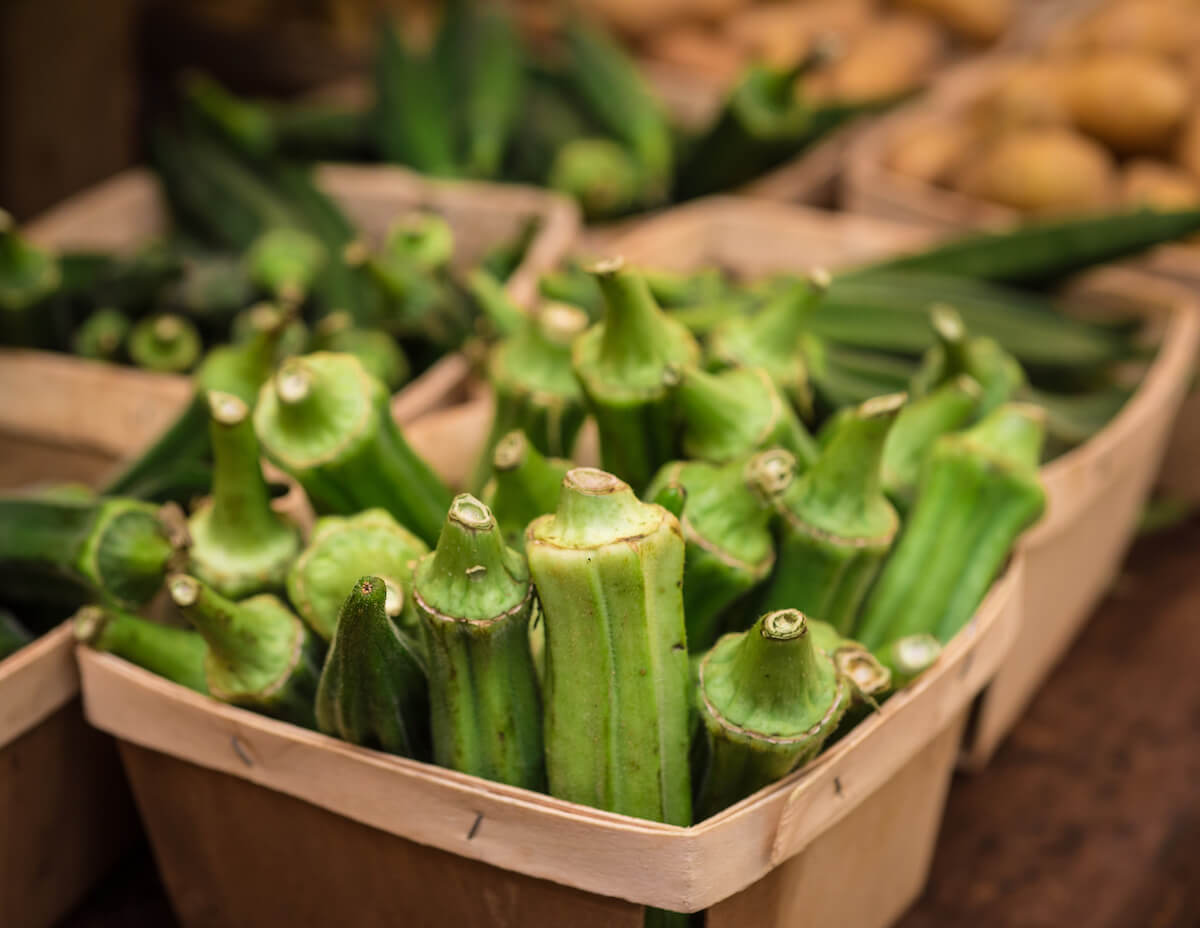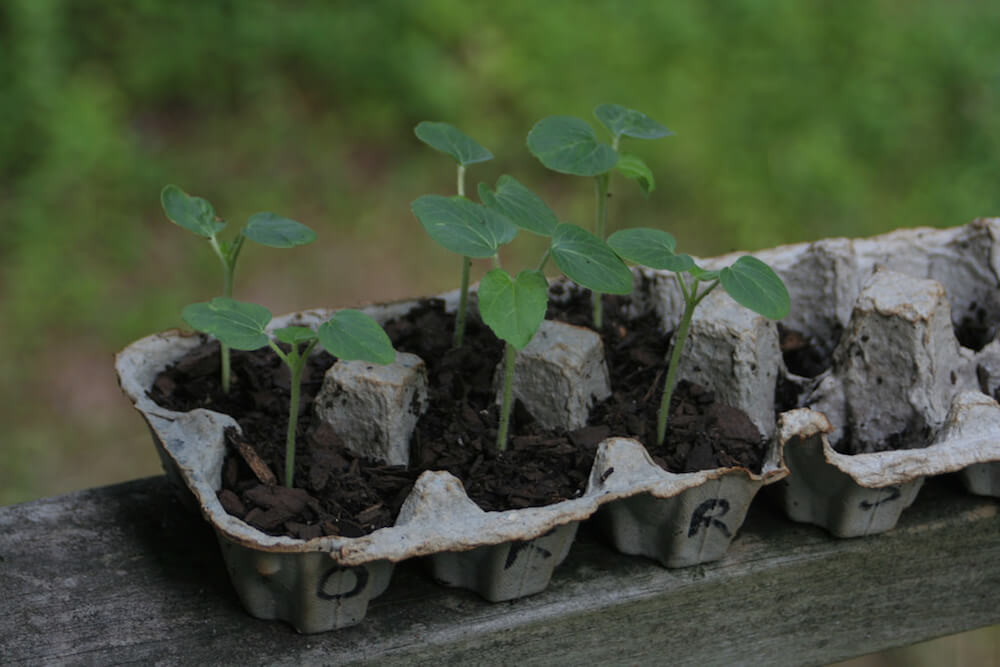Companion Planting For Okra • Insteading

Companion planting is an pure strategy of sickness and pest administration accomplished by planting two or additional kinds of vegetation, which have advantageous symbiotic relationships, shut to 1 one other inside a delegated or confined yard home to the benefit of plenty of of the neighboring vegetation.
Selecting the proper “good neighbors” for okra reduces undesirable insect predators, attracts helpful bugs, promotes pollination, enriches the soil, and offers selection and visual curiosity to the yard.


Best Companion Crops For Okra
Plant every kind of every sweet and scorching peppers between okra vegetation. Sturdy and sturdy, okra vegetation act as a “windbreak” for the additional fragile pepper vegetation. In flip, pepper vegetation repel cabbage worms, which want to munch on okra.
Plant sunflowers throughout the perimeter of your yard in order so as to add a splash of coloration and as a way of pure insect administration. Sunflowers act as a powerful entice for aphids. Intensely drawn to the sunflowers, they go away your okra, tomatoes, and pepper vegetation alone.
Plant basil throughout the bottom of your okra vegetation. Plant on the very least six inches apart so the basil can unfold out. Basil repels whiteflies, aphids, and spider mites.
When lettuce and okra are planted collectively, the okra affords shade for the lettuce whereas the lettuce acts as an attractive, edible groundcover that chocks out weeds throughout the bottom of the okra plant. On account of lettuce has a very shallow root system, it would not compete with okra, peppers or tomatoes for nutritional vitamins.
Okra (Abelmoschus esculentus) is a tall-growing annual vegetable that thrives in warmth climates, in the midst of the most popular days of summer season.
Whereas okra could also be grown in most United States Plant Hardiness Zones, it is by customized a southern plant that does best in warmth, moist soils. This well-liked vegetable could also be current in every metropolis and rural homestead gardens because it’s easy to develop and is participating all by way of the rising season on account of its dense inexperienced foliage and beautiful flowers.
For homesteaders who promote their surplus crop manufacturing on the native farmers market, okra can return an income over an extended harvest interval of eight to 10 weeks.
Best Okra Varieties
Okra is throughout the Malvaceae (mallow) family of vegetation, which contains Rose of Sharon, hollyhocks, cotton, and hibiscus. Native to the Nile Valley, okra cultivation by Egyptians dates once more to the twelfth century B.C. From there, the favored plant unfold all by way of the Mediterranean, India, and Africa.
For homestead yard cultivation, confirmed producing varieties embody Labadi, Woman Finger, Bombo, Quim, Astern, and Clemson Spineless.
For ease of selecting, dwarf varieties are well-liked choices. Park’s Candelabra Branching, Annie Oakley, and Louisiana Inexperienced Velvet are low-growing varieties with dependable heavy yields: ready for choosing in 50-to-52 days.
Planting Concepts For Okra
Okra grows best in a full-sun location in nutrient-rich loamy soil with a pH of 6.0 or bigger. Take a soil sample to your native county extension service to verify pH and fertility ranges. Amend as helpful. Choose an area throughout the yard with good moisture retention. Okra will develop pretty correctly in heavier soils nonetheless cannot tolerate compacted hardpan, poorly aerated, or soggy soil.


To arrange the yard for planting okra, cultivate the soil to a depth of ten inches, breaking up grime clods and eradicating roots, rocks, and weeds. Enhance the soil by incorporating a generous amount of pure yard compost, well-aged herbivore manure (cow, sheep, goat, horse, llama) or a balanced 10-20-10 fertilizer.
Plant okra throughout the spring, after hazard of frost has handed. The plant thrives in warmth soil. For among the finest outcomes, delay planting until the soil has warmed to 50 ranges Fahrenheit. For an ample fall crop, plant okra three months sooner than the first autumn frost.
Whereas you possibly can start okra by sowing seed straight throughout the soil, gardeners positioned in climates with cool, damp springs, get a leap on the rising season by starting indoors 4 to six weeks sooner than spring planting time.
Related Publish: How To Develop, Protect, And Harvest The Okra Plant
Plant okra seeds one-inch deep. If sowing straight in soil, plant seeds two-to-three inches apart, thinning to at the very least one foot apart as a result of the seeds develop. Transplant when seedling are three-to-four inches tall.
Okra is a tall plant with some varieties exceeding six toes tall at maturity. To avoid shading out totally different crops, plant okra on the north end of the yard, near totally different tall vegetation equivalent to corn. Plant seedlings roughly one foot apart in rows spaced two to three toes apart.
Okra grows vigorously all through hottest summer season days. Whereas okra can tolerate drought circumstances, the hardy plant produces the perfect yields when equipped with a minimal of 1 inch of water per week.
Pest Points
Okra pest points embody cabbage loppers, aphids, stink bugs, and nematodes. Washing the plant in soapy water and rinsing with a gradual stream of water can take away aphids. The overwhelming majority of pests could also be managed by pure gardening methods.
The easiest strategy of organically controlling nematodes is to implement a observe of crop rotation, planting the soil the place you’ve got grown vegetation that enchantment to nematodes with small grains, grasses, chives, onion and garlic that cease a build-up of nematodes.
Companion vegetation help repel undesirable crop predators throughout the homestead yard.
Crop Rotation
On account of okra is sort of susceptible to wreck by nematodes, make use of a program of crop rotation. Okra should not be planted in soil beforehand utilized to develop vine crops equivalent to sweet potatoes and squash as these crops generally tend to increase nematode inhabitants in soil.
Nematodes feast on youthful okra roots, inflicting wilt and galls on the roots, which diminishes fruit yield. Administration nematodes with EPA licensed nematicides.
Moisture Requirements
Maintain the soil surrounding okra vegetation weed free and apply additional pure compost after the first harvest. When weeding by handpicking or hoeing, be careful to not hurt plant roots.
Harvesting And Consuming Okra
As a result of the plant matures, harvest youthful pods once they’re two to three inches prolonged. Pods are usually ready for harvesting inside ten days of flowering. Use yard scissors to clip immature pods every totally different day to encourage crop manufacturing.


Do not go away outdated pods on okra vegetation as it would sap vitality from the plant and cut back crop yield.
Current okra could also be saved throughout the fridge crisper for as a lot as 4 days. Discard any pods that develop to be bruised or discolored. To freeze okra, blanch sooner than freezing to guard freshness and style.
The plant accommodates a mucilaginous juice prized for its thickening prime quality made well-known by its use in Louisiana Creole gumbo dishes. Okra has a delicate, and significantly bland fashion, comparable in style to eggplant.
The tender, youthful seedpods are the edible part of the okra plant. Immature pods are served as a boiled, fried, or pickled vegetable; together with style to salads, soups, sauces, and stews. Okra is low in vitality, extreme in fiber, and provide of Vitamin A.
Best Ever Seafood Gumbo
My sister Bonnie, a connoisseur prepare dinner dinner and longtime resident of New Orleans, shared with me her favorite scorching and spicy gumbo recipe.
Parts
- One cup of white flour
- One cup of browned bacon bits and drippings
- One cup of chopped pink sweet pepper
- One cup of chopped inexperienced sweet pepper
- One cup of finely chopped celery
- One cup of chopped white onion
- Two tablespoons of freshly minced garlic
- Two tablespoons of minced current cilantro
- One pound of ground Italian sausage
- Three cups current sliced okra (Canned or frozen okra may be substituted.)
- 4 quarts of water
- Eight beef bullion cubes
- Three tablespoons Worcestershire sauce
- Two tablespoons soy sauce
- One pound lump crabmeat
- 4 kilos uncooked shrimp – deveined and peeled
- One tablespoon of freshly minced thyme leaves or half teaspoon dried thyme
- One quart of canned stewed tomatoes
- One six-ounce can of tomato paste
- Sea salt to fashion
- Three tablespoons bacon drippings
- Two tablespoons gumbo file
- Three teaspoons of scorching pepper sauce
- One teaspoon Cajun dried seasoning powder
- Three bay leaves
- One-half teaspoon of current ground cardamom
- Three tablespoons white rice wine vinegar
- Two tablespoons brown sugar
Directions
- Brown crumbled Italian sausage in a skillet. Take away from heat and put apart.
- Put collectively a roux by cooking the flour, bacon bits, and bacon drippings over medium heat in a heavy saucepan until the roux is clear and a rich darkish brown. Stir all the time to forestall burning and to accumulate a clear consistency.
- Add chopped sweet peppers, celery, onion and crumbled Italian sausage to the roux and prepare dinner dinner on low heat roughly 10-minutes until the greens are tender. Take away from heat and put apart.
- In the intervening time, as a result of the roux is simmering, in a giant stock or pasta pot carry water to a boil. Add bullion cubes, stirring until boullion is completely dissolved. Cut back heat to simmer. Add remaining spices, herbs, stewed tomatoes, tomato paste, brown sugar, and seasonings.
- To this mixture, add roux with sausage and greens. Simmer mixture over low heat for one hour, stirring typically.
- Soften three tablespoons of bacon drippings in a skillet over medium heat, Add okra, shrimp, crabmeat, and rice wine vinegar. Prepare dinner dinner mixture for ten minutes or until okra, shrimp, and crabmeat are tender.
- Add okra and seafood mixture to the gumbo pot and proceed to simmer over low heat for an additional two hours to meld flavors.
- Serve with a tossed inexperienced salad, crusty French rolls, and luxuriate in.
References:





